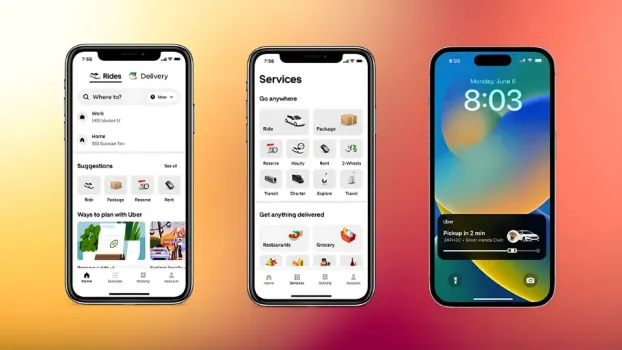Our Blogs

The Rise of Ransomware: How IT Services Can Safeguard Your Data
One of the biggest threats in the present world is ransomware. It is a type of ransomware, which infects a computer and locks down the files while asking for money to unlock the computer. As companies use digital assets to run their operations, it is more important than ever to have proper Ransomware Protection. In response to this, Cybersecurity has made it possible for organizations to adopt Data Safeguarding Solutions through IT Services to fend off such attacks and protect businesses from unknown threats. In this blog, we will also understand ransomware how it works, why it is becoming more prevalent, and Cybersecurity Strategies that can be implemented to Protect Your Business Data. Are you ready to maximize the opportunities your business can create? Let our professionals guide you through implementing regular updates and solid enhancements to your website. Contact us today! Understanding Ransomware: A Growing Cyber Threat Ransomware has changed its face and aims not only at big businesses but also at small companies, healthcare providers, and schools. Attackers capitalize on existing weaknesses, then lock the important files and deny access unless the criminals are paid. Ransomware costs are enormous, measured both in terms of cryptocurrency and in damage, such as loss of business operations, reputation, and regulatory penalties. It is important to adopt measures in Ransomware Protection in their early stages in order to avoid these risks. Why Ransomware Attacks Are on the Rise Several factors contribute to the rise of ransomware: Increased Remote Work: The transition to remote work has increased opportunities for threat actors that, in turn, have increased opportunities for threats. Sophisticated Malware: Today’s ransomware has sophisticated encryption and its propagation capability is higher and can easily bypass all types of detection. Lack of Preparedness: It is sad that many businesses have inherently weak Cybersecurity Strategies to protect them against such violations. If businesses want to protect themselves against the ever-increasing threats there is always an IT Service for Cybersecurity to help them strengthen their security. Measures in Preventing Cyber Ransomware Attacks Regular Backups: All data that can be addressed must be backed up and encrypted to avoid giving the hacker any leverage for the demand for a ransom; the backup is to be stored in a location that is not connected to the internet. Employee Training: Inform employees to recognize phishing e-mails and other forms of social engineering which are common means of delivering ransomware. Endpoint Protection: Prevent ransomware at source, at the endpoints, which are often ignored by traditional network security tools. Zero-Trust Architecture: Control access to any sort of information or any program, which should not be opened by unauthorized personnel. All these are part of the Data Safeguarding solution for they represent key steps in protecting the shopped assets. Use of IT Services in Cyber Security Professional IT Services for Cybersecurity are specialized, and many businesses struggle to have these services and products in-house. Key benefits include: Real-Time Threat Monitoring: Outsourced IT services apply hi-tech interfaces to track and respond to ransomware risks with absolute immediacy. Vulnerability Management: These frequent scans help to know your vulnerabilities in infrastructure and rectify them before the hackers get a chance at them. Incident Response: If there is an attack then the IT teams offer a solution on how to contain the damage and move into recovery mode. Customized Solutions: Besides, Specific business requirements of data safeguarding are met in the case of Tailored Data Safeguarding Solutions leading to improved security provisions. With professional services, it is certain that businesses are well prepared to Secure Business Data from complex threats. Measures for Safeguard against Ransomware It becomes clear that technology remains at the core when it comes to enhancing the wall against ransomware. Some essential tools include: Firewall and Intrusion Detection Systems: Limit access and detect with success the intrusion attempts. Advanced Endpoint Security: Pioneering in AI – this is how ransomware protection for devices can be effectively detected. Email Security Solutions: Avoid phishing which are common tactics that may introduce ransomware. Data Encryption: Encrypt data to make them utterly meaningless even if these get into the hands of the attackers. The spending on these technologies enhances Ransomware Protection and establishes a good security structure. See Also: Wonderful Tips to Design an Excellent Landing Page Looking for ways to advance your business? We have experts who will ensure that your website suits your needs as you need it. Get started with us now! Final Thoughts Ransomware has become prevalent and proves that security can almost never be reactive. Through procurement of IT Services for Cybersecurity, and integration, enforcement, and encouragement for Data Safeguarding Solutions, any business organization can reduce its exposure drastically. Securing your data is not just an issue of technology; it is an issue of business. If you are ready to grow your business and fortify your security, we are ready to help. Call or email us today and let us help you Secure Your Business Data Efficiently FAQs: Q1: What is ransomware protection and why is crucial? A1: Ransomware Protection looks at measures that can be used to avoid ransomware, discover it, and also to solve the issue, to protect priceless information. Q2: What would IT services for cybersecurity do and how would it help protect businesses? A2: IT Services for Cybersecurity provide constant system watching, risk assessment, consultancy on the best approach in handling cyber threats, and regular analysis among others. Q3: Which data protection measures can be applied against ransomware? A3: Data backup, endpoint protection, zero-trust networks, and employee awareness are part of Data Safeguarding Solutions. Q4: What measures should be adopted in organizations to deal with ransomware attacks? A4: There is a way that Businesses can Prevent such attacks and these include; Phishing training, Endpoint protection, Secure backups, and Strong access controls. Q5: What is the role of zero trust in cybersecurity? A5: Zero-trust means that only checked users can work with the data, which minimizes the likelihood of a breach and ransomware.
Read More
How to Optimize IT Infrastructure for Growing SMEs
While the expanding SME IT infrastructure continues to spiral, IT becomes a constraint to productivity and efficiency. It is always difficult to follow increased demands, and, being cost-efficient at the same time. Effectively structuring the SME strategic IT infrastructure guarantees growth and competitiveness is achieved. This guide looks into ways through which SMEs can leverage cost-effective IT infrastructure with the view of expanding and meeting the ever-growing IT requirements. Are you ready to maximize the opportunities your business can create? Let our professionals guide you through implementing regular updates and solid enhancements to your website. Contact us today! 1. Understand the IT Challenges of Growing SMEs Fast-moving is particularly a challenge to SMEs IT in the areas of equipment, capacity, processes, and security. These directions create adversities which in turn hamper efficiency and stop organizations from being successful. Key IT Challenges for Growing SMEs: Lack of scalability on current frameworks Reduced operational efficiency which leads to high cost of operations Insufficient data protection tools Lack of proper management of information technology (IT) resources Recognizing these points of discomfort is the first step towards supplementing or seeking help for your infrastructure optimization process. 2. Evaluate your Current IT Environment First of all, they should assess their existing structure to identify the potential problems—concern with performance, capacity, and security. Steps to Assess IT Infrastructure: Scan for proper performance by the hardware and operating system, for software programs. Use cases in defining the type, capacity, and scalability of storage solutions at IT facilities. Evaluate 3 aspects of your network such as reliability and speed. Check security measures for new threats. This assessment provides the foundation for developing a strategy map for IT development for growing SMEs. 3. Adopt Scalable IT Solutions For how to leverage IT infrastructure, consider which ones support your business, you expand and develop without having to replace all the time. Scalable IT Solutions for Small Businesses: Cloud Computing: Mechanisms of such platforms are quite versatile; Amazon Web Services, for instance, or Microsoft Azure. Virtualization: Simplification is where the multiplicity of servers is realized to be a factor of inefficiency and high expenses. Modular Systems: Invest in systems that offer the opportunity to make upgrades in bits and pieces for instance storage arrays. Scalability guarantees that your IT infrastructure will remain flexible for your expansion without costing a lot of money. 4. Welcome Efficiency through the Automation of Processes Automation is useful to eliminate the disproportionality of transferable benefits toward increased utilization of IT solutions in small business growth. Benefits of Automation: Reduce manual errors. Enhance decision making by freeing up resources to focus on strategic tasks. Helps to make tasks that require an extensive amount of time, for example, typing in data or producing regular reports, considerably quicker. Utilize technology that corresponds to such as RPA (Robotic Process Automation) and ITSM (IT Service Management). 5. Focus on Security The cyber threats increase towards those growing businesses since they counter them as opportunities to capitalize on. It is better when optimized for SME purposes; one area of focus must be security features to implement. Security Strategies: Consults the use of firewalls, antivirus, and IDS systems. Maintaining security protocols means that one is continuously updating systems in an effort to close exposed gaps. Generally, educate employees about cybersecurity measures. Safe computer networks are an asset that safeguards your information, inspires the confidence of your customers and clients, and saves your business from expensive leaks. 6. Choose Affordable Strategies for IT Infrastructure Resource constraints are a feature of many SMEs, and thus, limiting factors such as cost have to be taken into consideration. Tips for Cost-Effective IT Strategies: Use open-source software whenever it does make sense to do so. Request IT services from third parties to decrease expenses inside the firm. Flexibility and lower initial costs can be achieved with subscription-based services. These strategies make it possible for SMEs to maximize their existing and potential IT needs while at the same not breaking capital banking on. 7. Strategic Planning of IT Solutions Making updates a regular thing allows you to keep your systems running at maximum efficiency while meeting the needs of your business needs. IT upgrades for growing SMEs are that they ensure that your firm does not lag due to outdated equipment. Upgrade Essentials: Upgrade old computers to better-performing brand-new ones. Develop the proper high-level data storage and management system. Replace old network equipment with new ones to enable high-speed connectivity. System updates enable you to compete effectively in the market and deal with ever-changing competition. 8. Fixing and Improving Each Time Optimization is not just a one-time process. It makes your IT infrastructure for SMEs adaptable in accordance with your changing needs when performed in a routine manner. Continuous Optimization Tips: Business intelligence can also be used to assess system and database performance. Conduct security checks within your company. Collect employee opinion on IT performance. In this way, it is possible to improve continuously and discover that there are problems that need to be sorted out in advance. See Also: Wonderful Tips to Design an Excellent Landing Page Looking for ways to advance your business? We have experts who will ensure that your website suits your needs as you need it. Get started with us now! Final Thoughts IT must be aligned for the SMEs for the proper running of business and growth, as the IT infrastructure is of paramount importance. Starting from scaling the business and being safety, the possibilities of achieving effective cost of IT infrastructures, you will be able to provide yourself from the competitors. Need expert guidance? To guarantee that the growth of your infrastructure will continue to support your business, contact WebOConnect for customized IT solutions. FAQs: Q1: How many SMEs experience what IT issues and what are they? A1: Lack of scalability, increased security threats, existing systems and high operational costs are some of the biggest bottlenecks affecting SMEs. Q2: How can SME strengthen its IT strategies for a cost effective solution? A2: Include cloud or Web-based applications, get third party services, and use leasing of software for discounted initial costs. Q3: What makes scalability a crucial factor in implementing and managing IT infrastructures? A3: Elaborate systems enable you to expand your infrastructure as your business expands, and not require constant replacement. Q4: How do IT upgrades help SMEs? A4: They eliminate system failure and enhance maximum efficiency hence increasing the businesses effectiveness in their operations. Q5: From an ICT4D perspective, what is the place of monitoring in IT optimization? A5: Most importantly, monitoring is concerned with efficiency, performance measurement, and conformity with growth requirements in an organization’s IT setup.
Read More
From Flashcards to AI: The Evolution of Digital Language Learning Tools
The evolution of the technology applied to language learning has been a revolution, from a flashcard tool to AI Learning Apps. The history of the language learning digital tools reflects on how the learning process was transformed from basic memorization techniques to complicated technology-enhanced learning systems. This blog is devoted to presenting key concepts for a foreign language, the use of technology in language acquisition, the evolution of language, and the creation of contemporary tools for language learning. Are you ready to begin your second Mobile app? Here are the best app developers to help us create your perfectly designed customized app. Contact us now! 1. The Early Days: Flashcards Tools Originally, there were what we called Flashcards tools for learning languages. Some of these cards physical or digital helped in making vocabulary building very easy. To memorize some words and phrases users would repeat them using the practice called spaced repetition. While basic, the card language is the foundation for a much more organized technique of picking up vocabulary that incorporates flashcards. Digital versions like Anki allowed you to choose the set of cards you would like to have in your deck, while Quizlet, for example, made quizzes, and challenges funny and more like a game. As simple as they are, flashcards are still used nowadays in the language learning process, primarily as adjuncts to more complex systems. 2. Increased use of Digital Language Platforms The 2000s became a turnpike in the history of application-based language learning tools such as Duolingo, Babbel, and Rosetta Stone. I popped up with such platforms that intermingled interactivity with structured curricula to enhance the learning processes. Their strengths lay in offering flexibility: learners could progress relaxed with pace and goal choice and get immediate feedback. This period saw the learning process come from rote learning to a more contextual one that encouraged knowledge in grammar, listening and cultural aspects. 3. Contemporary Approaches to Second Language Learning Today, the primary tools and methods of mastering a language are already advanced from the initial fundamentals. The enhanced applications often use media, games, and realistic conversation practice and engagement. Some of these are game-based apps such as Memrise, which incorporates videos from native speakers, and Tandem which offers users real conversation partners. Mondly AR tools go further and engage the learners through graphics displayed within the learner’s immediate environment in order to create a clear link between what is learned in class and what is practically applicable. These tools demonstrate how technology is able to meet students’ particular needs as learners. 4. Artificial Intelligence vs Traditional forms of learning It is also good to have a look at the more recent development which is artificial intelligence. Savings can be divided based on error checking, analysis of choices and feedback, and recommendations as well as individual courses with different approaches and real practice in communication with applications such as ChatGPT and Grammarly. When comparing AI vs traditional learning methods, it is clear that one of the biggest advantages of AI learning is its flexibility and possibility to expand. AI adapts the lesson, the mode in which it is delivered to the learner, and the velocity of learning compared to the traditional methods, wherein an instructor delivers lessons. However, conventional approaches are also significant to encourage face-to-face communication and cultural believability. 5. Application of Technology in Second Language Acquisition From the days that technology was used for mere help in memorization processes, it is now being widely used for helping in the understanding and practical application of information. The amazing thing about tools is that they are designed to cover all aspects of language learning from reading and writing to speaking and listening. This AI with its functions to emulate communication enables learners to address speaking anxiety. Besides, tools such as Rosetta Stone or Mondly that enable recognition of verbal utterances together with a pronunciation check may be seen as a translation between learning and practice. 6. Language Development with the Latest Technologies Languages are not only taught through but also informed by technology. In this particular context, the language change brought by digital tools has generated new channels to interact. Emojis, GIFs, and Slang are from the Internet and social media forums and are gradually becoming part of mainstream language. Furthermore, as the current machine translation tools such as Google Translate expand, they erode barriers to inter-group interactions and learnings. 7. The Future: AI Learning Apps and Beyond Language learning of the future is undeniably going to be powered by Artificial Intelligence. Apps such as the learning app Duolingo Max using GPT-4 advanced AI is determined to support hyper-individualization for education. These tools can estimate the requirements of a learner, adjust to his or her performance, and offer interesting exercises connected with the learner’s hobbies. Other forms of digital technologies are Virtual reality (VR) and AR which also offer some interactiveness, like practicing a language in a virtual caf or during, say, a market, thus building up confidence in a learners when they encounter similar situations in the real world. Thinking about elevating your taxi booking business? Our expert developers are here to develop the perfect taxi booking app. Reach out to us now! Conclusion Years of advancements from Flashcards tools to smart apps to learn with the help of AI prove how technology has influenced language learning. Efficient not only in terms of technical language acquisition but, to an even greater extent, as part of the languages’ development process due to the tools used in communication. Moving to the future, the combination of AI and IT with reference to virtual reality will help to expand the understanding of language comprehensively, actively, and efficiently. Need professionals to translate your idea into reality? Get your perfect solution from WebOConnect today – just request a consultation for your digital language plan now! Contact us today! FAQs Q1: What has been the background to the development of technology to support language learning for a long time? A1: It transformed from simple NANDA tools like Flashcards to more sophisticated platforms as well as improved AI learning based on personalization. Q2: What is the difference between AI vs traditional learning methods? A2: AI brings customized, cost-efficient training, which, on the other hand, focuses on exposure to a specific culture & actual communication. Q3: What are modern techniques of language learning? A3: Other examples of these technologies are AI apps, gamified platforms, augmented reality tools, and apps based on conversations such as Tandem. Q4: What role does technology play in language learning today? A4: Every aspect of learning and language development is made more convenient by the use of technology through creating an effective learning environment that is controlled to meet the needs of every learner. Q5: In what ways do learning applications based on artificial intelligence affect the foreign language learning perspective? A5: They provide lessons one one-on-one, instant feedback, and an engaging environment for learning the language needed.
Read More
How Generative AI Is Revolutionizing IT Services: What Businesses Should Know
Generative AI arrives in IT Services to fundamentally change the industry and enhance its performance beyond recognition. Ranging from simplifying the most challenging operational tasks to improving customer satisfaction, AI-driven IT Service Innovation is gradually becoming the means by which enterprises establish themselves in today’s competitive environment. This blog post discusses the topic of Generative Artificial Intelligence’s Effect on IT services business and shares some ideas on the topic. Are you ready to strengthen your business potential? Let our experts help you implement regular updates and ensure robust website enhancements. Contact us today! What Is Generative AI? Generative AI can therefore be defined as modern machine learning models that are able to generate human-like text, images, code, and even solutions. Unlike conventional AI where the computer programs work based on a set formula, Generative AI for Business Solutions employs the use of neural networks to innovative solutions. This capability of ‘thinking’ and ‘creating’ does make generative AI something of a trendsetter in the process of redesigning IT services across the sectors. Business IT and The Age of Artificial Intelligence The AI Revolution in Business IT is driven by generative AI’s ability to optimize and innovate processes: Automation of Repetitive Tasks: Automation of various processes decreases human intervention, and allows for more comprehensive tasks. Data-Driven Insights: AI looks at huge masses of data, and provides directives for wise decision-making. Personalized User Experiences: The EE technology of generative AI can make interfaces, responses, and services unique to each individual user. Cost Reduction: Outsourcing of IT services lowers costs while levels of operation are kept high The use of automation on routine IT services ensures that costs are kept down while more efficient levels of operation are achieved. Thus, generative AI is not only a technological phenomenon but also a mandatory tool for companies of the twenty-first century. How AI Transforms IT Services Business Solutions, generative AI, and customized solutions to address each industry challenge: Healthcare: AI diagnostics merged with patient data management enhances care delivery. Finance: Those generative AI technologies have greatly simplified fraud detection and risk assessment. Retail: Personalized recommendations score higher on customer satisfaction and sales. Manufacturing: AI optimizes the supply chain and reduces production inefficiencies. These applications demonstrate how companies can leverage generative AI for real, measurable outcomes. Business - Orientated Generative AI solutions Failure to maintain regular updates on their website security can turn to be catastrophic: Loss of confidentiality: In the lack of update and patching as termed, the websites create virtual open doors for hackers. Data Breaches: Customers’ information may be hacked or utilized in the wrong way. Downtime and Financial Loss: Recovery from an attack, of course, is also expensive and requires ample time and effort. Reputation Damage: A hacked website loses clients’ confidence thus leading to customer loss. To safeguard your site, be sure to upgrade and be aware of these expensive hazards. AI-Driven IT Service Innovation Practice Innovative usage scenarios that define the AI revolution in Business IT: Predictive IT Support: AI anticipates potential system failures, allowing proactive maintenance to avoid disruptions. Dynamic Resource Allocations: AI-based cloud systems dynamically allocate resources within actual time demand. Automated DevOps Pipelines: Generative AI for automatic testing and deployment cuts the time-to-market for new applications. Intelligent Knowledge Management: AI curates and organizes company knowledge for easier access by teams. Such developments essentially make AI-driven IT service innovation indispensable for future-proofing the IT infrastructure. Challenges in Implementing Generative AI in IT Services Despite its advantages, integrating Generative AI in IT Services comes with challenges: Data Privacy Concern: Sensitive business data requires strict security measures. Implementation Costs: High initial investment in AI technologies can deter small businesses. Skill Gaps: Training employees to work with AI tools remains a challenge for many organizations. Ethical Considerations: De-biasing AI models ensures that the decision process is fair. Businesses must overcome these challenges to gain the maximum out of Generative AI in IT Services. See Also: Wonderful Tips to Design an Excellent Landing Page Looking for ways to advance your business? We have experts who will ensure that your website suits your needs as you need it. Get started with us now! Final Thoughts No more a sci-fi term, generative AI is revolutionizing the approach of businesses toward IT services. From automation of processes to enhancing user experience, the impact of Generative AI on IT Services is pretty deep. Ready to engage generative AI in IT services? Make contact with WebOConnect today and revolutionize your enterprise with world-class AI solutions. FAQs: Q1: What is Generative AI, and how does it benefit IT services? A1: Generative AI creates outputs, automates tasks, and enhances efficiency, transforming IT services profoundly. Q2: How can generative AI improve customer support? A2: AI-driven chatbots provide personalized, instant resolutions 24/7, enhancing customer satisfaction and reducing costs. Q3: What challenges do businesses face in adopting Generative AI in IT Services? A3: Common challenges include data privacy, implementation costs, skill gaps, and maintaining unbiased AI models. Q4: How does generative AI enhance cybersecurity? A4: It detects anomalies, predicts threats, and automates responses, strengthening cybersecurity frameworks significantly. Q5: Why is generative AI important for future IT services? A5: It drives innovation, efficiency, and scalability, ensuring IT services stay competitive and future-ready.
Read More
The Importance of Website Security Updates
Having strong website security is not a luxury in today’s internet environment. Websites have become the subject of cyber attackers who take advantage of old systems and programs. Security updates are critical in all website security, data protection, and maintaining clients’ trust in your website. This blog is to understand what a website security update is, why should you update it, and how it tries to protect your website with updates. Are you ready to strengthen your website’s security? Let our experts help you implement regular website security updates and ensure robust website protection. Contact us today! Why Update Website Security? Securing a website requires regular updates to get rid of a number of risks as well as to save private information. Here's why: Combat Emerging Threats: What is important to understand is that each year attackers improve their tactics of the attack. Website security updates are always effective in warding off current threats to the website. Data Integrity: Minimise instances of hacking and other cases of unauthorized access to the user's sensitive data. Compliance Requirements: There are industries where there are regular update requirements on the grounds of regulations compliance. User Trust: People are more likely to deal with your company and purchase products and services from you when they are confident that they are safe engaging with your company online. Failing to have updates for such sites places your site at risk with some of the dangers being hazardous to your reputation and your business. Benefits of Regular Website Security Updates In addition to defending the website against cyber threats, consumers will find the following advantages of the website security update: Here’s how they contribute to a secure and efficient website: Enhanced Performance: Updates may contain performance improvements to maintain the stable performance of the software. Improved Features: It is often the case that the replenishments for security purposes also enhance the usability of software. Cost Savings: Frequency prevents you from realizing high costs as a result of breaches or system downtimes. SEO Protection: A secure website does not suffer any penalties from search engines, and would retain its rankings. It must be emphasized that updating importance cannot be overemphasized as a proactive measure toward the future, stability, and growth. How to Secure Your Website with Software Updates Security involves constant updates hence the need to ensure any site you develop is up to date. Here’s an app stack selection guide to follow: Use Automatic Updates: Always allow auto-update for your CMS, plugins, and software when it is possible. Audit Plugins and Themes: Modify and/or uninstall the presented third-party extensions that are no longer supported or incompatible with newer versions of web browsers. Backup Regularly: Before making changes of updates, it is recommended to perform a backup of the site likely to cause data loss during the updating process. Test in a Staging Environment: To spare your live site from potentially major problems, always apply updates to a staging site first and check for problems. In this manner, you will be able to protect your website using updates and will not allow risks to drag you down. Results of Not Acting on Security Alerts Failure to maintain regular updates on their website security can turn to be catastrophic: Loss of confidentiality: In the lack of update and patching as termed, the websites create virtual open doors for hackers. Data Breaches: Customers’ information may be hacked or utilized in the wrong way. Downtime and Financial Loss: Recovery from an attack, of course, is also expensive and requires ample time and effort. Reputation Damage: A hacked website loses clients’ confidence thus leading to customer loss. To safeguard your site, be sure to upgrade and be aware of these expensive hazards. Types of Security Updates Security updates can be ones, twos, or threes depending on the kind of problems in the operating system. Here's a breakdown: CMS Updates: Such platforms as WordPress freely update frequently to patch vulnerabilities in the content management systems. Plugin and Theme Updates: Third-party tools may be accompanied by patches for newly discovered bugs. Server Updates: Make sure your hosting provider performs changes at the server level to keep your account safe. SSL/TLS Updates: It is crucial to ensure continued security in the transmission of data, so ensure that you are using the most recently developed encryption procedures. Such systematic updates across these categories are important for the optimum protection of websites. Checks to Frequently Update the Website Security To maintain a secure website with software updates, follow these best practices: Monitor Updates: For this, you want to use the tools or services that can tell when the updates are out. Set a Schedule: Make it a routine to set time for revision and implementation of the changes made. Hire Professionals: If you are not trained well enough, you can always hire a web security expert who will carry out the updates. Educate Your Team: Educate employees about security patches on the website, and let them learn how to identify various risks. By doing so, a lot of time is saved, and the method ensures that the updates are well-rounded in making the website leakproof. See Also: Wonderful Tips to Design an Excellent Landing Page Looking for ways to enhance your Website Security? We have experts who will ensure that your website suits your needs as you need it. Get started with us now! Final Thoughts The question of updating website security cannot be considered unimportant. Continuous relative alteration of site software prevents potential threats, optimizes the visitors’ experience, and maintains the site's reputation. Hence, by keeping the website up to date you can protect the data from getting leaked, follow all compliance rules, and secure for users. Ready to secure your site? Start paying attention to updates today and do not let your business rely on possible weaknesses you have not foreseen. Get your perfect solution from WebOConnect today! Contact Now! FAQs: Q1: What advantages can stem from occasional updates on website security? A1: They help organizations and their stakeholders to minimize dangers, excel, and meet set guidelines. Q2: How does website security need to be updated often? A2: Updates are important because they protect the site from new threats and maintain its stability in the face of continually emerging cyber threats. Q3: In what ways does security update help to secure your website? A3: They cover up flaws, build up protections, and minimize the threats of intrusion or cyber theft. Q4: What are the consequences of not applying security updates regularly? A4: Failure to establish an obligation to act, gives a company increased exposure to risk, including data loss, systems downtime, and reputation loss. Q5: What are the techniques for managing software updates for site security? A5: Allow for automatic updates, plugin audits, data back up, and testing of updates on a staging server.
Read More
How to Build a Social Media Platform Like Instagram
Social media has rapidly become the driving force that has changed the way people interact and share information. If you want to build a social network, let alone something like Instagram, you need to plan, be inventive, and, most importantly, think about your users. In this Instagram app development guide, find out about general and specific processes, app features, price range, and trends. Are you ready to begin your second Mobile app? Here are the best app developers to help us create your perfectly designed customized app. Contact us now! 1. Interpreting the Structure of the Social Media App Market When developing a social media app, it’s important to consider what social media apps are available out there now. Currently, social applications shift toward the use of video, personalization, and engagement tools such as Stories, Reels, or live streaming sections. There is also an increasing need for specialized sites to address certain categories of consumers’ interests. Key trends to consider include: More attention is being paid to short-form video content. AI and AR have added value for improving various aspects of user experiences. DIY approach in app design, with the consumers being willing to give their data to only those platforms they know are safe. If you want your app to hit the market with flying colors, you need to keep yourself abreast of these trends to know how best to meet user expectation and expectations. 2. Basic Requirements of Social Media Applications If you want to design and develop an application similar to Instagram, then there are few more components that need to be implemented with the aim to get the people involved and make them come back to the app. Here are the must-have social media features: User Profiles: Facilities that enable users to set up their profiles that include user details, profile images, and tags as well as biodata. Content Sharing: This allows the users to share photos, videos, and messages and has features that allow them to be retouched with some effects like filters. Feed Algorithm: The feed: The possibility to create a feed with posts based on the preferences and actions of the user. Search and Explore: Allow users to perform an extended search, and show them popular content and relevant profiles. Social Interactions: Such as the options such as ‘likes, comments, shares, and DMs encourage user activity. Stories and Reels: Hedonic designs have become key components of social software due to the creation of fast, dynamic content. Notifications: Remind people that they like something or someone, they are followers, or they have a new message to see in the app. Security and Privacy: Such essential features like account security control, reporting and abusive content filtering, and data privacy should be well provided. The features mentioned above are fundamental to user retention and satisfaction of social media apps. 3. Processes of Developing a Social Media Application The creation of a social platform is considered to pass through various phases. Follow these steps to ensure a smooth development process: Define Your Niche: Figure out what this app can provide that no other app can effectively provide. For instance, Instagram started as a platform for sharing pictures but with an emphasis on minimalism. Research the Audience: By analyzing your target market and understanding the kind of features subscribers want, you will be in a good position to offer them what they want. Create a Wireframe: Create an outline to define the user navigation and activities on an application. Choose the Right Tech Stack: Choose software instruments and frameworks that will be appropriate for scaling and effective work of your app. Develop the MVP: Release a basic product that has only enough features to ensure you can get user feedback and check its viability. Iterate and Scale: Leverage user feedback to enhance the function and then, over time integrate the complex capabilities. Following the steps indicated here, you will have a good start towards developing a successful Instagram app. 4. Marketing Cost to Develop a Social Media Platform The expense of creating social media varies by product, incorporation of features, and place where the developers are situated. Basic MVP: The estimated cost ranges from $25, 000 to $50,000 for the basic features, which would include things like user profiles, posts, and notifications. Full-Scale App: From $100,000 to $300,000 for additional features such as AI-supported feeds, Stories, and AR features. Ongoing Costs: These are the constant costs including hosting, updates, and marketing. Purchasing high-quality development also guarantees a good user experience and the expandability of your website. 5. Monetization Strategies To make your social app profitable, c onsider these monetization methods: In-App Ads: To target users add relevant ads based on their preferences. Subscription Plans: Provide paid services in addition to your basic service. E-commerce Integration: Enable customers or retailers to make their products available within the application. Sponsored Content: Lease equipment for paid advertisement. If you manage to incorporate these strategies into your platform, then you can develop a long-term income source for it. 6. Issues to Consider when Using Application for Instagram Building a platform like Instagram comes with challenges, including: Scalability: The app needs to be optimized so that when the number of registered users increases its functions will operate optimally. Data Security: Preventing unauthorized access to and unauthorized exploitation of users’ information. User Engagement: Experimenting as much as it needs to and when it needs to in order to maintain the users’ attention. The challenges enumerated in this course can be addressed and fixed as the application is being developed to attain a stronger and more competitive application. See Also: Wonderful Tips to Design an Excellent Landing Page Looking for ways to advance your Mobile application development? We have expert app developers who will ensure that your app suits your needs as you need it. Get started with us now! Final Thoughts Before developing an application like Instagram, you should realize users’ requirements, trends, and basic functions. Keep concentration in the areas of scalability, security, and monetization to establish a platform that will not only challenge the current social networking giants but adapt to their position. Need professionals to translate your idea into reality? Get your perfect solution from WebOConnect today – just request a consultation for your social platform development plan now! Contact us today! FAQs: Q1: What is the ultimate cost of creating a social media platform? A1: Depending on the complexity, it cost between 25000$ to create an MVP and up to 300000$ for an app with all the features. Q2: What are the important characteristics of social media applications? A2: A clear user profiles, content sharing and discovery through feed, feed algorithms, search options, notifications, our Stories and advanced privacy settings. Q3: Which tech stack is the most suitable for social media app? A3: React is chosen for the front end, Node.js – for the back end, while AWS is to be implemented for scaling. Q4: How long does it take to construct a social media application? A4: Development for a product takes 6-12 months based on the degree of difficulty and number of attributes. Q5: How to make money off of a social media application? A5: In-app advertisements, prepaid services, and product sales, and paid product placements as some of the viable methods of developing sustainable income streams.
Read More
How to Develop a Ride-Sharing App Like Uber
Creating an effective ride-sharing application similar to Uber needs good planning, a highly functional application, and a keen focus on trends in the market. The market of ride-sharing remains active, also providing passengers with comfort and comfort in using the service. However, to compete effectively, you need to concentrate effort on perfecting the integration of features of the right ride-sharing app, and in the selection of technologies that will effectively serve the intended aim. Below is a blueprint you may find helpful to set the gears toward the creation of a functional ride-sharing app in motion. Are you ready to begin your second Mobile app? Here are the best app developers to help us create your perfectly designed customized app. Contact us now! Step 1: Segmentation, Analysis, and Targeting of Consumers Before you start app development, correctly define the trends in the on-demand ride-sharing market. Know why people use apps like Uber, its location tracking, drivers’ reviews, and easy payment methods. Key trends include: Sustainability: Some other services – green ride-sourcing which includes the use of electric cars or shared mobility. AI Integration: Improving the users’ experience with the help of prediction and intelligent routing. Multi-Modal Services: Additional services like cycling with rented bicycles or incorporating public transport services. Therefore updating your app with these trends as they occur makes your app relevant. Step 2: Fundamental Structure of Ride-Sharing Application For successful Uber app development, include these core features of ride-sharing apps: User Panel: Sign up and sign in using an email, a phone number, or social networks. Real-time location tracking. Choice of services available (on-demand service and pre-booked service). Order payment options for credit cards, wallets, and other means of payment. Driver Panel: Driver registration and verification. Trip requests that include options of accepting or rejecting a particular request. Earnings dashboard. Facility of Navigation Support with GPS integration. Admin Panel: User and driver management. Ride analytics and reports. First and foremost, a detailed system of fare and commission management. Services and ways of conflict solving. These aspects of ride-sharing apps establish convenience for the users, the drivers as well as the administrators who use the application. Step 3: Technology Stack for the Ride-Sharing Applications Select an efficient technological platform and infrastructure to develop an app that is as efficient as Uber. Key components include: Front-End: Cross-platform development with the help of React Native or choosing between React Native and Flutter. Back-End: Node.js or Django for handling server-related processes. Database: MongoDB for Big data and PostgreSQL for structured data. Payment Gateway: Stripe, PayPal, or Razorpay for secure transactions. Maps and Navigation: Free real-time GPS tracking or the Google Maps API or Mapbox for tracking current routes. Selecting the correct stack means that your ride-sharing app development process meets the business objectives. Step 4: Design the User Experience Your application must have an appropriate user interface (UI) and experience (UX) to be a success. Focus on: Simplicity: It is critical that navigation, as well as booking, procedures remain as easy as possible. Real-Time Feedback: Include location tracking features, which include the ETA and also details about the fare. Accessibility: Make sure that the app is understandable for any person, including disabled people. Ease of use increases uptake and leads to the improvement of satisfaction. Step 5: Development and Testing The actual ride-sharing app development process involves: Prototyping: Develop a wireframe to illustrate what the functionality of an app will look like. Development: Design the app based on agile which means that you can use different approaches during the construction phase. Testing: Perform intensive checking of the program to find defects that may affect the program’s functionality on computers or other devices. Testing arranges a completely bug-free application which is very essential for repeat usage by the clients. Step 6: Calculate the Cost That the Ride-Sharing App Would Take As is to be expected, it is difficult to give a definitive price tag of building an Uber app because it depends on the number of features you want, the complexity of the app, and the location of the development team. Basic App: $20,000–$40,000. Advanced App: Research has also shown that the cost varies in the range of $50,000– $100,000+ for more advanced features such as Artificial Intelligence and requests for multi-modal transport options. Factors Affecting Cost: Development time that will be required to create this product, features that will be included such as the abilities of the software to work with payment gateways and better navigation. Awareness of the total cost structure of an application used in ride-sharing makes it easy for one to plan how to balance the expenses. Step 7: Launch and Marketing After development, focus on a strong launch strategy: Pre-Launch Buzz: However, before launching the programs, teaser campaigns should be used to create buzz for the offers. Promotions: Give the first few users a good deal and convince them to recommend others. Feedback Loop: Open collecting of user's feedback for further improvement of the Website. Proper planning and implementation during the website launch make user acquisition and retention easier. Step 8: Scaling and Future Growth Once your app is established, the goal is then to manage the flow required for satisfying a significant number of users as this is one of the biggest drivers of consumer dissatisfaction. Add advanced features like: Subscription Plans: Provide special offers to its customers in terms of a package whereby clients with high usage of the product will be charged less. Regional Expansion: Another suggestion of the use is to present the application to new cities or countries. Partnerships: Offer the possibility to order something special in cooperation with various companies. Duration is important in a competitive market in order to ensure scalability for longevity. See Also: Wonderful Tips to Design an Excellent Landing Page Looking for ways to advance your Mobile application development? We have expert app developers who will ensure that your app suits your needs as you need it. Get started with us now! Final Thoughts Building a ride-sharing app entails major considerations in terms of planning, essential feature set, and constant adherence to the trends in the on-demand ride-sharing app market. So that you can create an app like Uber useful for people and maintain its position in the market, follow these steps. Hire a professional now to develop a ride-sharing app! Fortunately, our team at WebOConnect can offer support through all of them – from idea to development. Contact us today! FAQs: Q1: What can be considered the key elements of ride-sharing applications? A1: Some of the main features of ride-sharing applications are tracking systems, payment interfaces, driver’s dashboards, and simple booking options. Q2: What is the cost of creating an application like Uber? A2: Estimates for creating an app like Uber cost around $ 20,000-$ 100,000; nonetheless, the final cost is going to depend on the features that have to be added. Q3: What is the better tech stack for building ride-sharing apps? A3: The programming languages that are widely in use for ride-sharing app development are React Native, Node,js, and MongoDB while the Google map API is also used for creating map integration. Q4: What trends should be taken into consideration when developing ride-sharing mobile applications? A4: A look at emerging trends in on-demand ride-sharing applications such as integration with Artificial Intelligence, availability of environmentally friendly car models, and flexibility of using multiple means of transport. Q5: How long would it take for someone to create a ride-sharing application? A5: Duration for different types of development may differ still, creating a functional app may take 4-6 months on average based on the specification.
Read More
How to Create a Buy Now, Pay Later App Like Affirm
The demand for BNPL services has rapidly grown over the last few years as more and more customers have opted for flexible payment methods. Affirm, for instance, is among the apps that have changed how people use their mobile devices to shop by offering a consumer a chance to pay for a product in installments. Learning these steps is crucial when creating a Buy Now Pay Later app as they underscore the basic tenets needed for a high–performing app. This blog looks at how to develop a BNPL app like affirm, BNPL app features, the cost of BNPL app development, and how to develop a payment app like affirm. Are you ready to begin your second Mobile app? Here are the best app developers to help us create your perfectly designed customized app. Contact us now! Understanding the Buy Now Pay Later Industry The growth of the Buy Now Pay Later industry has been spurred on by changing customers' needs and expectations in the market. BNPL services enable users to obtain goods at the point of purchase and pay in a smaller and more flexible manner. Since such innovation completely does away with credit scores and creel rates, are low or zero, which implies that applications such as Affirm target more people, especially the young ones. Analyzing the recent market research, BNPL market around the world is anticipated to reach more than $ 40 billion in 2030. This shows the great opportunity that businesses might create their Affirm apps and get into the market. Key Buy Now Pay Later App Features To create a BNPL app like Affirm, certain features are essential to attract users and streamline payment processes: User Registration and Verification: make sign-up processes easier by using methods that can be used to verify the user's credentials with ease. Merchant Integration: Integration with the e-commerce platform or with several retailers guarantees a high level of acceptance. Payment Management: Offer number installment quotes, payment frequencies, and regularities for the users concerned. Credit Scoring: Integrate better algorithms in the App that automatically check users’ credit worth without pulling their credit score. Transaction Security: Use encryption and other form of fraud detection to assist with secure transactions. Customer Support: Include live chat or in-app support to handle queries so that you can attend to them in the shortest time possible. Adding all these features to the BNPL app enhances its competitiveness and the convenience of the platform. How to Make a Buy Now Pay Later Application Market Research: Identify target customers and market competitors as well as trends: characteristics of currently trending Affirm app features and concerns. Define Features: As a result of the research, conclude what the special selling propositions of the app are and which features are most crucial. UI/UX Design: Make work with the interface easy and smooth, creating an appealing layout for every user in mind. Back-End Development: Create well-guarded servers and APIs, which also guarantee the seamless working of payment gateways. Compliance: Comply with grey laws such as the PCI DSS regulation for payment and another regional fiscal standard. Testing: Test all components directly for any technical or user interface problems at the user interface. Launch and Market: Install it on the correct channels and spread about it in the right manner to get to the target clients. Following these steps should help you build a payment application like Affirm that will meet customer expectations. Cost of Developing Buy Now Pay Later Apps The exact cost of creating apps for BNPL depends on the features, the kind of complexity of the project, and the region of development. Here’s a breakdown: Basic Features: 12,000-20,000USD (User registration), 20,000-35,000USD (payment integration). Advanced Features: This range goes to $ 100,000 (Credit scoring, analytics, fraud detection). Custom Design: Costs $10,000-$20,000 for target interfaces. Ongoing Costs: There are additional expenses that amount to $10,000 – $15,000 yearly for the purpose of website maintenance, hosting, and updating.b If a company wants an excellent BNPL app with additional features, they can spend at least $150,000 for this feature. Difficulties in Developing an Application of Buy Now Pay Later While the opportunities are immense, creating a BNPL app also comes with challenges: Regulatory Compliance: Traversing financial laws of various jurisdictions could be a real challenge. Fraud Prevention: Personal protection from fraud as well as providing a neat interface to the users is achievable with the help of modern instruments. Merchant Partnerships: It may take some time for organizations to build rapport with the retailers as well as the online marketplaces. Managing these challenges effectively guarantees long-lasting success once you develop a Buy Now Pay Later app. Characteristics That Set Affirm Apart Understanding Affirm app features can inspire your app’s development strategy: Flexible Installments: Customers are free to select payment methods and structures such as no interest. Credit-Free Approval: Affirm operates on soft credit checks for approvals which means that most people should qualify for this product. Transparent Pricing: There are no additional charges related to the service, nor are there extra charges for overdue payments. Retailer Integration: These relationships further strongly boost Affirm’s value proposition with the largest merchants. These aspects can help your app to be unique in husting among all other applications in stores. See Also: Wonderful Tips to Design an Excellent Landing Page Looking for ways to advance your Mobile application development? We have expert app developers who will ensure that your app suits your needs as you need it. Get started with us now! Final Thoughts To create a BNPL app such as Affirm, the most crucial aspects to consider include convenience, clarity, and security. The opportunity of the industry growth presents perfect chances for businesses that wish to develop Affirm apps to benefit from the expanding buy now pay later industry. Having the correct strategy and features, you can make your product stand out, and become attractive to both users and merchants. Are you looking to develop a BNPL app? Contact us for professional advice on design, development, and integration. Welcome to your turnkey solution for the development of your visions into successful apps. FAQs: Q1: What is key to look for in a BNPL app? A1: The key areas of the BNPL apps’ functioning include payment protection, merchants, instalment flexibility, credit checks, and customer support. Q2: How much does it cost to develop an application for BNPL? A2: The company noted that developing BNPL applications costs at least $50,000; bespoke pricing ranges from $50,000 to $150,000 depending on the features and app complexity. Q3: What are the causes of the BNPL market’s growth? A3: This segment is rapidly growing due to the rising demand for better payment solutions and, especially, interest-free payment plans. Q4: How do you secure BNPL apps? A4: Secure online payments option through integrating encrypted payment gateways which ensure high level of security parameters including fraud detection measuring up to the PCI DSS standards and protocols. Q5: What is then special about Affirm in the world of BNPL? A5: The important highlights of Affirm app include installment, pricing and merchant acceptance; which assists in establishing the trust of the users.
Read More
How to Build a Language Learning App Like Duolingo
Currently, technology is making people seek for more engaging and easy to use language learning solutions. Leading a market in language learning apps, Duolingo has become a gold standard for entertainment and efficiency. To help anyone interested in developing an app similar to Duolingo, this guide will also explain the steps, features, and approximate costs of developing the language learning app. Are you ready to begin your second Mobile app? Here are the best app developers to help us create your perfectly designed customized app. Contact us now! 1. Identify trends in the Language Learning App Market While the global trends related to language learning apps continue surging into the future, they expose further expansion with users in increasing their engagement with apps for language learning. Duolingo proved that people are ready for freestyle and game-based language learning. Since the dimension of mobile use increased, language apps remain popular and address students around the globe. If you want to break into this promising market, this is the right time to think about language learning app development. 2. Main Functionalities of Language Learning Applications When planning on the development of Duolingo app functionalities, concentration should be made on the production of functions that will be entertaining while at the same time delivering optimum results and being easy to use. Here are some essential language app features to include: Onboarding and User Profile Setup: Allow the user to establish goals, language, and learning preferences as well as the learning level. Gamification Elements: Users should be motivated using streaks, badges, and a couple of leaderboards. Lesson and Quiz Modules: These tutorials include structured lessons with quizzes at the end that allow for retention of materials learned as well as mastery of new materials at every session. Speech Recognition: Enables users to interactively learn the correct intonation patterns, which are very important components of a language. Vocabulary and Grammar Practice: Teach and use additional mime plays, such as flashcards, sentence construction, and other drill-like activities to reinforce language development. Progress Tracking: Inform the users of the progress achieved since this will help to motivate them and in the process make the options selected more personalized. Social Features: Social sharing and friend challenges should be used for competitive learning. Push Notifications: Inform the users to get back on track and consolidate the knowledge gained daily. The features of language learning apps such as Duolingo contain all facets, which distinguish the process of learning with pleasure and interest, so, the user is involved during the whole process. 3. Technology Solution for Language Learning Mobile Application This empowerment enables the development of the functionalities of the Duolingo app by selecting of the right tech stack. Consider the following recommendations: Frontend: Either end up accepting React Native for the true react native experience or Flutter for the native look-alike user experience. Backend: There are different options, which are Node.js or Django, for handling server-side operations. Speech Recognition API: The tool can also be Google Speech API or Apple Speech Framework for patterns of pronunciation. Database: Firebase or MongoDB would be the best for handling user management, tracking, and content storage. Analytics: Google Analytics or Firebase Analytics are your best tools for tracking user engagement and optimizing your app. The components explained above are synthesizable into the language learning application to ensure high performance, scalability, and adherence to market standards. 4. How To Build An Application Similar To Duolingo It was shown that creating a language learning app needs to be done in a very methodical way. Here’s a roadmap for your Duolingo app development guide: Market Research and Planning: Define the specific user base you want to attract and then the language, optional features, and appearance. UI/UX Design: The structure and design of an interface should be as simple as possible, easy to understand, and as visually appealing as possible. MVP Development: This should begin with a minimum viable product (MVP) that will consist of those primary components of the language app such as lessons, quizzes, and users’ profiles. Speech Recognition and Gamification: Apply game principles and speech recognition as the major functions to enhance the interactivity of learning. Testing and Quality Assurance: The app must be free from bugs and must function well on any device that it is installed. Launch and Marketing: Launch your app and then use advertising to go out looking for the learners. If you follow this Duolingo app development guide, you will know how to develop an application for learning languages with the necessary characteristics users want. 5. Monetization Strategies It will then be monetized, thereby reinventing the cost of making the language learning application actual and further improving it. A few are common, such as: The Freemium Model: It's interesting that the segregation of free and paid services lies in very minimal functionality to one and restricted access to the other. Subscription Plans: Using some of your content charging your users monthly or yearly for accessing the special services. In-App Ads: Free users should also run display ads but be careful with how you do it so that you do not irritate or demotivate your users. One-time purchases: Some of the perks are for a lifetime, including extra lessons, and cost a certain fee. The idea is to have partnerships and affiliate programs with any other brands or education-related businesses so more income-generating techniques can be available. All of these models can make money with the value that all of the users derive from your application. 6. Cost to Create an App like Duolingo It might cost at least $5000 up to $ 50,000 to create an application like the language learning application Duolingo, but it all depends on additional functions, complexity level, and the region of developers. Here’s a rough breakdown: Basic App with Essential Features: $20,000 - $40,000 Mid-Level App with Gamification & Speech Recognition: $40,000 - $80,000 Advanced App with Customization and AI-Powered Features: $80,000 - $150,000+ One way to do this is by understanding that the cost which is involved in the development of Duolingo can be greatly controlled through the development of an MVP with features being grouped according to the importance of being scaled with time. 7. Difficulties In Developing An App For Learning Languages Creating a language learning app comes with unique challenges, such as: Content Quality and Structure: Thanks to this skill, make sure the lessons provided are topic-wise complete, exciting, and developed according to users’ levels. User Retention: Language learning apps are still quite new; the use of gamification as well as constant app updates keeps the users engaged. Complexity of Speech Recognition: To provide feedback about the correct pronunciation involved a rigorous speech recognition system. Localization for Multiple Languages: Localizing the app for specified languages and cultures is a delicate process including a lot of investigation and trials. Approaching such challenges has to be done carefully: resolving them will contribute to creating successful apps, such as Duolingo. 8. Feedback and Launching of Your App One must do pre-launch testing on the different devices to be used to ensure that performance is standardized. Beta-testing can be used to gather user feedback as well as to find out whether any changes are needed. However, after the app has been developed and launched, it should be subjugated to constant updates based on the users’ feedback. If a language learning application is developed and launched with a basic good groundwork and feasible marketing strategies, then the market could be easily captured. See Also: Wonderful Tips to Design an Excellent Landing Page Looking for ways to advance your Mobile application development? We have expert app developers who will ensure that your app suits your needs as you need it. Get started with us now! Conclusion Creating a language learning application that resembles Duolingo is an opportunity in an already growing market. Using highly desirable trends, and needs of users, and applying gamification, options of speech, and interactive components, one can design a successful application. Having chosen the right technology stack, a monetization model, and knowing the cost to build a language learning app, you can acquire an outstanding application. Are you more focused on creating a language-learning application? We can help with every step of the process, helping your final app to be both useful for users and a pleasant surprise for them. It’s good to start building your vision now! Contact WebOConnect today for solutions on how your mobile app can generate revenue as soon as you’re ready to start making money. FAQs: Q1: How much would it cost to create Duolingo like language learning applications? A1: The price ranges from $20000 to $150000 respectively for features, complexities and region of development. Q2: What should not be missing in language applications? A2: These are: gamification, speech recognition, progress bar, lessons, quizzes, and easy-to-understand welcome message. Q3: How long does it take to create such an application as Duolingo? A3: On average, app development may take between 3 to 9 months if the application is built from the ground up. Q4: To what extent can gamification be incorporated to language learning apps? A4: Application of game elements increases the use of your product, the engagement, and persistence of consumers, as learning becomes fun. Q5: What criteria should be useful when selecting the appropriate tech stack of a language learning application? A5: Choose the tools which allow to create scalable, game-like and interactive application: React Native, Node.js and Firebase.
Read More












